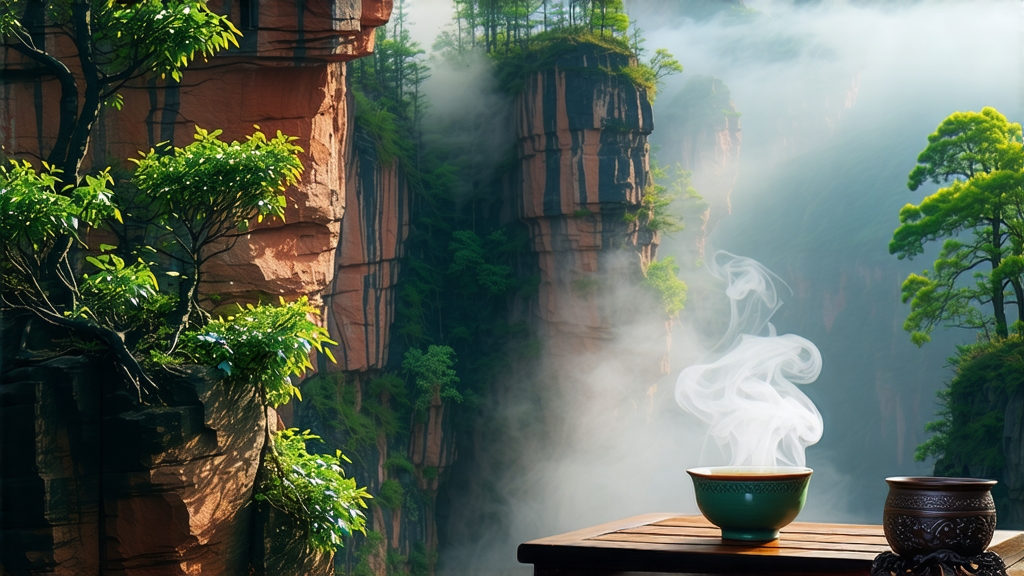
If green tea is the dew of spring and black tea the hearth of winter, then Da Hong Pao—literally “Big Red Robe”—is the echo of stone and fire that lingers between seasons. Hailing from the vertiginous Wuyi Mountains of northern Fujian, this oolong commands a mystique so potent that Chinese emperors, Tang-dynasty poets, and modern tycoons alike have weighed its leaves against gold. To understand Da Hong Pao is to step into a micro-universe where geology, myth, and human artistry converge in a single cup.
1. Origins: when legend meets basalt
The most repeated story dates to the Ming dynasty. A scholar, en route to the imperial exams, collapsed with fever on the sheer cliffs of Wuyi. Monks from a nearby temple brewed leaves plucked from six ancient bushes rooted in the canyon’s crevices; the infusion revived him. The scholar went on to top the exams, returned in gratitude, and draped his crimson imperial robe over the bushes—hence the name. Whether apocryphal or not, the tale cemented the tea’s reputation as a life-giving elixir. By the Qing era, Da Hong Pao was tribute tea, couriered northward in bamboo-lined chests to the Forbidden City.
2. Terroir: the “rock rhyme”
UNESCO lists the 60-kilometer Wuyi gorge as a World Heritage biosphere for good reason. Granite cliffs, roasted by subtropical sun and cooled by mountain mist, fracture into mineral-rich scree. The soil’s pH hovers around 4.5, perfect for Camellia sinensis var. sinensis. Creeks atomize into perpetual fog, slowing leaf growth and concentrating aromatic compounds. Locals speak of yan yun—“rock rhyme”—a tactile finish reminiscent of wet slate after rain, a terroir signature impossible to replicate even in neighboring valleys.
3. Taxonomy: mother trees, clones, and blends
Only six original “mother” bushes still survive on Tianxin Rock, their gnarled trunks older than 350 years. Since 2006 the government has forbidden commercial picking, turning them into living fossils guarded by CCTV. What reaches the market today falls into three tiers:
- Bei Da Hong Pao (Northern DHP): Cuttings vegetatively propagated from the mothers, grown within the 60 km² core scenic zone. These “purebred” bushes yield the highest mineral complexity.
- Que She (Sparrow Tongue): A prized clone selected for its small, sparrow-tongue-shaped leaves and lilac nose.
- Commercial Blends: Skillful marriages of several Wuyi cultivars—Rou Gui, Shui Xian, Tie Luo Han—crafted by master blenders to approximate the mothers’ profile at accessible prices.
4. Craft: the dance of bruise and blaze
Da Hong Pao is the most oxidized among Chinese oolongs (50–70 %), yet its soul is forged by fire. The 24-hour production cycle begins at dawn when pickers select the standard “zhong kai mian” leaf—three half-mature leaves and a bud. Withering under the morning sun softens cell walls, followed by indoor withering on bamboo racks where leaf moisture drops to 65 %. The critical “yao qing” (rocking-green) stage sees the leaves tumbled in wicker drums every 20 minutes; edges bruise against ribs, triggering enzymatic oxidation that turns the rim mahogany while the veins stay jade.
Once the leaf emits a ripe-peach aroma, firing halts oxidation. But Wuyi artisans do not stop there: they charcoal-roast the leaf three times over 60 days using local hardwood. First roast at 120 °C drives residual moisture; second at 90 °C deepens the bouquet; final “foot fire” at 70 °C polishes texture. Between roasts the tea rests in earthen jars, allowing internal moisture to migrate outward—an echo of Spanish ham curing. The result is a leaf that is blacker than many black teas yet still biologically oolong, its inner chemistry rewired by Maillard sugars and pyrazines that taste of toasted sesame and cacao.
5. Brewing: the gongfu dialogue
Western teap